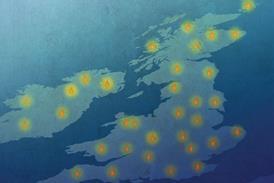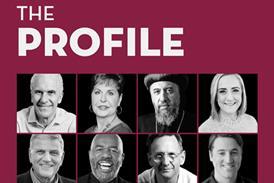Given it’s his birthday (kind of), it’s only fair we get to know the real Yehoshua ben Yehoseph. Jared Brock separates fact from fiction
Have you noticed how most non-Christians don’t like Christianity, but are generally positive about Jesus? Pretty much everyone I know – Christian or not – has feel-good vibes about the person we call Jesus of Nazareth.
But how well do they really know him? Do they know his politics, his economics, his mission? Do they know that he didn’t just have twelve disciples, or that they weren’t all men? Do they know what he looked like, what he wore, what he ate or what he actually did for a living? Do they know the shadowy crime family who killed him – or why? Do they even know his name wasn’t actually Jesus?
Let’s dive into six of the most common myths about the Son of God.
1. His name was Jesus
The angel who appears to Mary (Miryam in Hebrew, Miriam in Aramaic) says: “You will conceive in your womb and bear a son, and you shall name Him Yehoshua” (see Luke 1:31, NASB1995).
Does she know the name literally means Yahweh saves?
Does she savour the name on her tongue and sound it out? (“Yeh-ho-shoo’-ah”).
It’s like three names squished into one: Yahweh for Jesus, Elohim for God and Ruah for Spirit.
Is his name…a trinity?
Before we continue, let’s iron out how, exactly, a boy named Yehoshua ben Yehoseph ended up with the name ‘Jesus’. The Hebrew name Yehoshua gets transliterated into Aramaic as Yeshua, which gets transliterated into Greek as Iesous, which gets transliterated into Latin as Iesus, from which we get the English ‘Jesus’.
Mary and Joseph’s everyday tongue was Aramaic, so there’s a good chance they called him Yeshua – or some nickname derived thereof. Because his earthly father’s name was Joseph – or, in Hebrew, Yehoseph, he was Yehoshua ben Yehoseph. His was the sixth-most popular male name among Jews of the era – and 21 different Yeshuas appear in the volumes written by Roman-Jewish historian Josephus. We know that Joseph’s father’s name was Jacob. If Jesus were born today in the West, we’d probably call him Josh Jacobson.
2. He had long hair and wore a robe
Not one of the biblical authors spends a word on Yehoshua’s physical description. Biblical authors tend to mention when people are exceptionally tall (Goliath, Saul), voluptuously fat (Eli, Eglon), climb-a-tree short (Zacchaeus), unusually hairy (Esau), ridiculously strong (Samson), incredibly handsome (Moses, David), exceedingly beautiful (Rebekah, Tamar, Esther), or have particularly luscious locks (Samson, Absalom).
That Yehoshua is described as neither the Hunchback of Notre Dame nor a Middle Eastern male model perhaps indicates that there was nothing special about him physically to point out. If this is the case – and one certainly should not build a theology on it – we can conjure a pretty fair picture of what the Nazarene may have looked like. We simply need to ask: what did an average adult male Jew from the tribe of Judah look like in first-century Judea?
Based on skeletons recovered from the time and place, the average male was just five feet five inches tall. This aligns with the Roman historian Suetonius, who considers five foot seven to be respectably tall. Biologically, the people that best approximate Yehoshua’s skin tone are today’s Iraqi Jews, descendants of those forced into Babylonian exile in 586 BC. They mostly have beautiful, honey-coloured or olive-brown skin, brown eyes and black hair.
If Yehoshua wore his hair in the style of men depicted in portraits and coins from his era, it was likely clipped short, not the flowing mane we see in many religious paintings. Long hair was considered culturally unmanly, as we read in 1 Corinthians 11:14.
Yehoshua probably didn’t wear a long, showy robe, either. In Matthew 23:5, he criticises luxury and fashion. In Mark 12:38-39 he mocks people who wear posh religious robes. Instead, he more likely dressed like most other men: an undyed, tasselled cloak, worn over a cheap, knee-length tunic. In other words, he looked like the revolutionary Middle Eastern rabbi he was.
3. He was a carpenter
How did Yehoshua ben Yehoseph make money and pay his bills? What did he do for a living? The Sunday school answer to the first question stitches together Mark 6:3 and Matthew 13:55: Yehoshua takes after his stepfather Yehoseph and becomes a carpenter. But the Bible never says he worked specifically with lumber.
Yehoshua refers to wood only twice in the Gospels: once in his famous log-in-the-eye illustration, the other a passing mention of dried-out wood in Luke 23:31. Not a single one of his 48 parables is about carpentry. On the other hand, he references rocks constantly, speaking of cornerstones (Mark 12:10), towers (Luke 13:4), walls (Matthew 21:33), building on rocks (Matthew 7:24-27), stones (Luke 19:40), winepresses (Matthew 21:33), millstones (Luke 17:2) and foundations (Matthew 7:24).
Galilee was so lacking in trees that it had to import wood from elsewhere. Most houses in Yehoshua’s day were built of stone. King Solomon had to hire Sidonian carpenters to teach his Israelite workforce how to work with timber because they simply didn’t know how. So why do Sunday school teachers around the world still say Yehoshua was a carpenter?
If Jesus were born today in the West, we’d probably call him Josh Jacobson
We may blame the translators of King James’ Bible. When they arrived at the Greek word tektón, from which we get the English word ‘architect’ (or chief builder), they translated it as ‘carpenter’. And it makes sense. In 1611, when the KJV was published, Greece was a nation covered in trees, as was England. Plus, isn’t there something poetic about a humble man hammering nails into wood, only to be nailed to a wooden cross himself?
But Yehoshua wasn’t Greek. His daily tongue was Aramaic, which means he would have called himself a haras/kharash – a builder-craftsman. There is a Greek term specifically for wood craftsmen, but Yehoshua is always given the more general term.
4. He had twelve disciples
If you ask the average churchgoer to name the twelve disciples, you are likely to hear “Matthew, Mark, Luke, John, Acts-ually, I don’t think that’s right. Wait a minute, let me see if I can remember…”
Here’s a handy way to remember them in English: Simon, Simon, James, James, Judas, Judas, John, Andrew, Bartholomew, Matthew, Philip, Thomas. Most of them get nicknames. For those keeping score, the group contains three business partners, two sets of brothers, two sets of friends, three of Yehoshua’s cousins and six fisherfolk. In other words, these men are already fairly well connected before Yehoshua brings them all into his fold.
But there were far more than just twelve disciples. The Gospel writers are clear that Yehoshua attracted and retained 70 disciples in short order, but we shouldn’t be too religious about that number either. Some texts say he had 72. And so, 70 may simply be symbolic – perhaps a shout-out to Moses’ 70 elders in Exodus 24:1.
At least two – Joseph (called Barsabbas, also nicknamed Justus) and Matthias – had first been disciples of John the Baptiser, and followed Yehoshua since John baptised him in the Jordan. In other words, they’d been around longer than many of the twelve. They remained faithful throughout the crucifixion and resurrection, and both were nominated in Acts 1:21-23 to replace Judas Iscariot. They were of such high character that the apostles had to cast lots to decide who to choose.
There were also five named female disciples, who played a central and sustaining role in Yehoshua’s rabbidom (Luke 8:1-3; Mark 15:40; ): Mary of Magdala, Joanna, wife of Chuza, Susanna, Aunt Salome (mother of thunder cousins James and John) and Aunt Mary (mother of cousin Little James). Mark 15:41 and Matthew 27:55 state that these women had followed Yehoshua since way back in Galilee.
This is a real mindbender for most churchgoers. We traditionally think of Yehoshua travelling with a dozen mature men, but in reality, the mostly teenaged troupe included a not inconsiderable number of women, including several of their own aunts and mums. When you add in the “many other women” that Mark mentions, you realise Yehoshua’s male disciples may have actually been outnumbered amid his 70-strong company.
Who were among his first disciples? Women. Who were the last disciples at the cross, despite the danger of being associated with a crucified criminal? Women. Who were the first to see him resurrected? Women.
The fact that scripture records the unseemly detail that Yehoshua’s ministry was funded by women only adds to its credibility. If you wanted to confer social proof on a rabbi, you would assign him patrons of the highest order, such as the high priest, King Herod or even Caesar himself. Instead, Yehoshua was supported by Maggie, Jo and Sue.
5. He was born on 25 December
Most historians no longer believe Yehoshua was born on 25 December – but they also don’t agree on an alternate date. We know early Christians didn’t celebrate Christ’s birth on 25 December from the writings of Irenaeus and Tertullian, who didn’t include it in their lists of Christian festivals. Origen suggests that the early Church didn’t celebrate Christmas at all, because first-century Christians believed only pagans celebrated birthdays!
We do know that, by AD 354, Christians in Rome were celebrating Christmas, likely under the direction of Pope Liberius. It was a wonderfully convenient date for the Catholic Church – 25 December did, after all, have several pagan connections that needed stamping out. But why should we be sceptical that Yehoshua was born on that date?
For one thing, arguments have been made that no one watched their flocks by night in December. With harvest long past, there would have been nothing for the animals to eat. Historians also doubt the Romans would have scheduled a tax census for the most inclement time of year. Temperatures in Bethlehem can drop below freezing in December, and arctic thermals and electric blankets weren’t exactly available with one-day shipping. Scholars have also argued it would have been nearly impossible for super-pregnant Mary to travel 70-something miles through hills that averaged 2,000 feet above sea level in the depth of winter, especially with precipitation making many roads impassable.
These are all interesting points, but the most intriguing has to do with Josh’s kinsman, John the Baptiser. Luke says that John’s father, Zacharias, “belonged to the priestly division of Abijah” (Luke 1:5). In 1 Chronicles 24, we learn that priests were split into 24 groups, each serving in the temple for one week, twice each year, from Sabbath to Sabbath. Luke tells us John was conceived after Zacharias had been serving in the temple – which dates it to around 24 June. If Mary visited six months later – late December – and found out she was pregnant, there’s no way she could give birth at Christmas, unless she somehow held Josh in the womb for a full year.
However, what if Yehoshua was conceived around 25 December and born on 29 September? A September birth makes it far more likely that shepherds would still be tending their flocks by night. It definitely makes more sense for a Roman census and a pregnancy pilgrimage. It doesn’t conflict with the astrological data and seems to jibe with the Jewish priestly traditions. Plus, it’s downright delicious from a symbolic perspective: Yehoshua entered the world to atone for our sins – and 29 September in the Jewish calendar may have been Yom Kippur, Judaism’s holiest date; the day of atonement.
If Josh was conceived on 25 December and born on 29 September, how did we mix it up for so long? The confusion could be explained by a clash between Roman and Jewish worldviews, and Eastern and Western thought. For Romans, the date of conception mattered more than the date of birth. In some parts of the East, birthdays are still derived from the date of conception, not birth. If we believe life begins at conception, then Yehoshua may have “appeared in the flesh” as a zygote on 25 December, even though he wouldn’t take his first breath for another nine months.
This, of course, brings us to Michaelmas.
“Michael-what?” evangelicals ask. In Luke 2:9, our doctor friend tells us that an “angel of the Lord” (commonly thought to be Michael the Archangel from Daniel and Revelation) announced the birth of Yehoshua to a bunch of shepherds: “I bring you good news that will cause great joy for all the people. Today in the town of David a Saviour has been born to you; he is the Messiah, the Lord” (v10–11).
No one watched their flocks by night in December
Take a guess at which day Catholics and Anglicans celebrate Michaelmas: 29 September.
No one knows when or why Christians started celebrating Michael’s announcement on this particular date, but since at least the fourth century. The word ‘Michaelmas’ means ‘Michael sent’, so the feast may well have started as a mass to commemorate the announcement of the heavenly host. But it is very strange to celebrate this at a completely different time of year to the actual birth!
Here’s another interesting coincidence: According to one calculation, 29 September, 4 BC, was the start of the weeklong Feast of Tabernacles, a kind of annual thanksgiving harvest celebration where all the pre-exile people of Israel dwelled in tent-like booths called tabernacles. When John penned his Gospel, he started with an evocative, esoteric prologue that includes a fun Greek word: “And the Word became flesh and dwelt among us, and we have seen his glory, glory as of the only Son from the Father” (v14, ESV, my emphasis). Interestingly, John doesn’t use the usual Greek word for ‘dwelt’. Instead, he uses the word for tabernacle. In the same way that Christians are described as temples of the Holy Spirit in 1 Corinthians 6:19, God is described by John as taking up residence in a physical body – he tabernacles among us.
What if Josh was conceived on 25 December and was born nine months later on 29 September? What if, on 25 December, we celebrate not Josh’s birth-day into the world, but more his actual physical incarnation? What if Michaelmas is actually Christmas, and the two are one and the same?
Heaven only knows.
Thankfully, the birth date of Yehoshua was of zero concern to the authors of the New Testament. The Gospel writers place much higher importance on theology than chronology, and so should we. Whether he was born or conceived on December 25, we celebrate the fact that the Light of life has entered the world.
6. His focus was on the afterlife
All of Rabbi Yehoshua’s teaching can be roughly boiled down to one core theme: the kingdom of God.
What is Yehoshua’s first public teaching in Mark 1:15? “The time is fulfilled, and the kingdom of God is at hand; repent and believe in the gospel” (ESV).
What is Yehoshua’s first public teaching in Matthew 4:17? “Repent, for the kingdom of heaven is at hand” (ESV).
What does Yehoshua say in Luke 4:43 when his disciples ask him to stay in Capernaum? “I must preach the good news of the kingdom of God to the other towns as well; for I was sent for this purpose” (ESV).
The Gospel writers place much higher importance on theology than chronology
Seventy-six of Yehoshua’s teachings are about this kingdom. The word used for kingdom was basileia, connoting a sense of dominion and domain. Governors and kings and Roman emperors had basileia. The kingdom of God is Yehoshua’s vision of YHWH’s total rule and reign over the universe. That will happen in the future. For now, the kingdom of God is wherever the rule and reign of God are present – be it one nation, one province, one city, one household or one heart. It has no physical boundaries. It cannot be contained. It is in this world, but not of this world.
The rabbi says the kingdom of God has already arrived (Matthew 11:12), but that it is also still on its way (Mark 9:1; Mark 14:25). When the religionists asked him when the kingdom of God would come, he told them it was already in their midst (Luke 17:21). In other words, Christ’s kingdom has stormed the beaches, but not yet retaken all enemy ground. It will – it’s inevitable, it’s unstoppable. Every knee will bow and every tongue confess that Jesus is the Christ (see Philippians 2:10-11).
This is the good news that the first disciples announced with their lives. Their message echoes through the generations, all the way down to those of us who proudly proclaim it to this day. By living out their gospel, it becomes clear that Christianity is not a moral position, rabbinical innovation, economic structure, philosophical system, political party or even a new religion. It is a living relationship with a person named Yehoshua ben Yehoseph.
In other words, it is a faithful friendship with a God named Josh.














![Jesus-myths-01-[Recovered]](https://d17xjl6rg4e8ic.cloudfront.net/Pictures/480x270/6/3/7/45637_jesusmyths01recovered_933246.jpg)























No comments yet